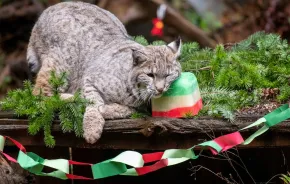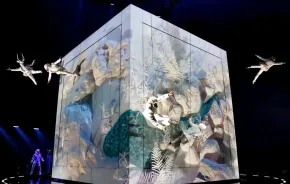"Please ring the bells and gongs."
This invitation to visitor interaction, printed in the Art and Trail Guide for the San Juan Islands Sculpture Park, sums up its appeal to families with kids.
The 19-acre reserve, located near Roche Harbor village on San Juan Island, doesn't look like much at first glance. A tawny meadow of unmowed grass, with a band of tall trees on the meadow's far south side, lies beyond the parking lot. Small planes take off from the airstrip across Roche Harbor Road and fly overhead. But open the forged-metal entry gate adorned with a small hummingbird sculpture, crossing a threshold mosaic of beach rock on your way in, and you'll begin to realize that there's more here than immediately meets the eye.
"We've become the major sculpture park on the West Coast," says founder and executive director Kay Kammerzell. Kammerzell, who had been deeply involved in the sculpture scene in Bellingham prior to moving to San Juan Island, had dreamed for several years of starting a sculpture park on her own. She and her husband finally quit their jobs and moved to the island, "not having a clue about how we were going to start a sculpture park." Initially, they thought they would have to find investors to buy land. After seeing the property, however, they convinced the owners, Roche Harbor Resorts, to loan the land in perpetuity to the park, arguing that it would become a destination and would draw people to the resort.
The land was designated as permanent open space and the sculpture park was established in 2001. It drew over 33,000 visitors in 2004. The 105 sculptures currently on view are loaned by the artists for one to two years, and include modern, representational and conceptual works, with art gates, bells and benches scattered around the grounds.
Visiting children may not know anything about sculpture, but they'll enjoy what amounts to a treasure hunt through open space and forest. Wide paths mown into the meadow -- a mix of rugosa roses and four-foot-high grasses -- lead to cul-de-sacs where sculptures are installed. Some are visible through the grass; others take visitors by surprise. The paths run south past the pond, which has sculptures positioned around the edge. Eventually the southward paths lead to the forest, which visitors enter through the steel Grape Leaf Gate by Tom Torrens.
The forest, which offers glimpses of Westcott Bay Marsh below, is several degrees cooler, a welcome change from the shadeless meadow, and features conceptual art installations that will spark kids' imaginations. You, by David Nechak, is a pair of PVC binoculars suspended from a frame. Thanks to a pair of mirrors installed in the eyepieces, the viewer becomes the subject of the artwork. Shirley Wiebe's Suspended Animation is a nylon scrim thrown over a rope with the seeming carelessness of a sheet on a clothesline. The scrim plays with the light that filters through the trees, and changes the forest behind it into a shimmering, surreal backdrop.
The reserve has no plans to tame the semi-wild landscape. "I think that one of the things that happens to people when they walk through the park is that they look at the man-made art and then start looking at nature in a different way," Kammerzell says. "Nature becomes more of an aesthetic visual experience." Indeed, one of the pleasures of viewing art in such a naturalistic setting is the juxtaposition of smooth, polished metal or granite forms against the roughness of grass or the shifting shadows cast by clouds.
Kammerzell considers the reserve an outdoor museum, but it's one where security guards are not watching your child's every move as you stroll through a gallery. "We encourage touching; we discourage climbing," she notes. In spite of the hands-on policy, there have been few problems with vandalism. "People are very respectful of the art," Kammerzell says. The benches located at various points around the reserve are works of art in themselves (look for the stunning Rest by Pat McVay, carved from a piece of salvaged old growth red cedar), but spreading out a picnic on them is also encouraged.
The reserve's Family Art Days, held on Saturdays in July and August, draw between 20-30 families every week to the white tents set up along the fence by the parking lot. Each week a different artist is scheduled to be on hand between 10 a.m. and 4 p.m. to lead free drop-in art projects.
Go
Reserve Info: San Juan Islands Sculpture Park is open 365 days a year from dawn to dusk. A donation of $3 requested, and trail maps are available at the gatehouse. Weekdays tend to be less crowded, even during the high season. Umbrellas are available in case of rain, and an all-terrain stroller should be able to traverse most of the paths. Bring hats and water on warm days. There are no baby-changing facilities and the restrooms are portable units.
Ferry Info: The ferry to Friday Harbor departs from Anacortes, an hour-and-a-half drive from Seattle. Expect long ferry lines during the summer and plan accordingly. For more information, visit wsdot.wa.gov/ferries/.
More to do: Visiting the reserve as a day trip from Seattle is possible, but it makes for a rushed day on the island. Luckily, San Juan Island offers plenty of other family experiences to while away the time after a visit to the reserve.
- Learn about the natural history of marine mammals at The Whale Museum in Friday Harbor, and then visit Lime Kiln Point to whale-watch from land during the prime viewing months of June-September.
- The fields at the Pelindaba Lavender Farm, which hosts a harvest festival in July, are open anytime for exploration.
- The San Juan Historical Museum hosts a series of summer concerts on Wednesdays from mid-July through August, and also provides a look at the island's fascinating history.
- San Juan Island National Historic Park, the site of the 1859 Pig War crisis between the United States and Great Britain, offers hiking, birding, historical artifacts and ranger-led activities and living history events during the summer.
- Pretty Roche Harbor is worth a stop to see the historic Hotel de Haro, take a hike through the lime kiln quarries and eat lunch at Lime Kiln Cafe, whose standard burgers-and-fries menu is enhanced by outdoor seating and a fine view of the marina and Haro Strait.
- For other hiking locations, with maps and pictures, visit sanjuanislandtrails.org .
This article originally appeared in the July, 2005 issue of ParentMap.











